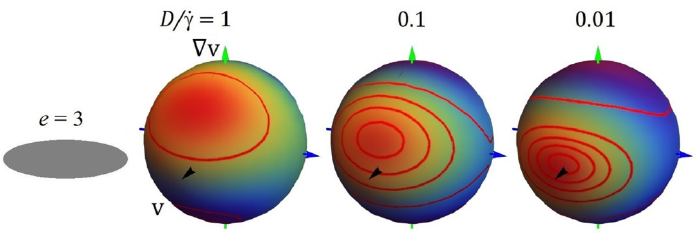
Aims and techniques:
Experimental and numerical studies were performed to study shear induced orientational phenomena in suspensions of elongated particles as well as in nematic liquid crystals.
Latest results:
| We studied the rotation dynamics of nonspherical particles in a shear flow in the presence of added noise in 3 dimensions. The Jeffery orbits of elongated (uniaxial, prolate) particles subject to noise were explored using Langevin simulations and a Fokker-Planck equation. We examined how the probability distribution of particle orientation changes when changing the rotation diffusion coefficient D (see figure). Various quantities (nematic ordering, biaxiality) are measured as a function of particle elongation and external noise. Phys. Rev. E 110, 044143 (2024) (download pdf) |  |
![[pattern-picture]](tegzeSM2020-fig2-3.png) Suspensions of neutrally buoyant
elliptic particles were modeled in 2D
using fully resolved simulations that provide
two-way interaction between the particle and the fluid medium.
Forces due to particle collisions were
represented by a diffuse interface approach that allows the
investigation of dense suspensions (up to 47%
packing fraction). We focus on the role inertial forces play at
low and high particle Reynolds numbers.
The suspensions are characterized by the
orientation distribution function (ODF) that reflects shear induced rotation of the particles
at low Reynolds numbers, and nearly stationary (swaying)
particles at high Reynolds numbers. In
both cases, orientational ordering differs qualitatively from the
behavior observed in the Stokesian-regime. The
ODF becomes flatter with increasing packing fraction, as
opposed to the sharpening previous work
predicted in the Stokesian regime. The ODF
at low particle concentrations differs significantly
for the low Reynolds number and inertial regimes, whereas with
increasing packing fraction convergence
is observed. For dense suspensions, the particle–particle
interactions dominate the particle motion.
Soft
Matter 16, 8925 (2020)
(download
pdf)
Suspensions of neutrally buoyant
elliptic particles were modeled in 2D
using fully resolved simulations that provide
two-way interaction between the particle and the fluid medium.
Forces due to particle collisions were
represented by a diffuse interface approach that allows the
investigation of dense suspensions (up to 47%
packing fraction). We focus on the role inertial forces play at
low and high particle Reynolds numbers.
The suspensions are characterized by the
orientation distribution function (ODF) that reflects shear induced rotation of the particles
at low Reynolds numbers, and nearly stationary (swaying)
particles at high Reynolds numbers. In
both cases, orientational ordering differs qualitatively from the
behavior observed in the Stokesian-regime. The
ODF becomes flatter with increasing packing fraction, as
opposed to the sharpening previous work
predicted in the Stokesian regime. The ODF
at low particle concentrations differs significantly
for the low Reynolds number and inertial regimes, whereas with
increasing packing fraction convergence
is observed. For dense suspensions, the particle–particle
interactions dominate the particle motion.
Soft
Matter 16, 8925 (2020)
(download
pdf)![[pattern-picture]](salamonJML2020-fig1b-2a.png) We studied
the rheological and rheo-optical
properties of suspensions of anisometric pigment particles in a
non-polar fluid experimentally. Different
rheological regimes from the dilute regime to an orientationally
arrested gel state were characterized and compared with existing
theoretical models. We demonstrate the intricate flow behaviour in
a wide range of volume fractions. A unique combination of the optical properties
of the particles results in a giant rheo-optical
effect: an unprecedentedly large shear stress-induced
birefringence was found in the isotropic range,
exhibiting a sharp pre-transitional behaviour. J.
Mol. Liq. 313, 113401 (2020) (download pdf)
We studied
the rheological and rheo-optical
properties of suspensions of anisometric pigment particles in a
non-polar fluid experimentally. Different
rheological regimes from the dilute regime to an orientationally
arrested gel state were characterized and compared with existing
theoretical models. We demonstrate the intricate flow behaviour in
a wide range of volume fractions. A unique combination of the optical properties
of the particles results in a giant rheo-optical
effect: an unprecedentedly large shear stress-induced
birefringence was found in the isotropic range,
exhibiting a sharp pre-transitional behaviour. J.
Mol. Liq. 313, 113401 (2020) (download pdf)
![[pattern-picture]](rollsmall.jpg)
![[pattern-picture]](spiral.jpg)
![[pattern-picture]](hiomu.jpg)